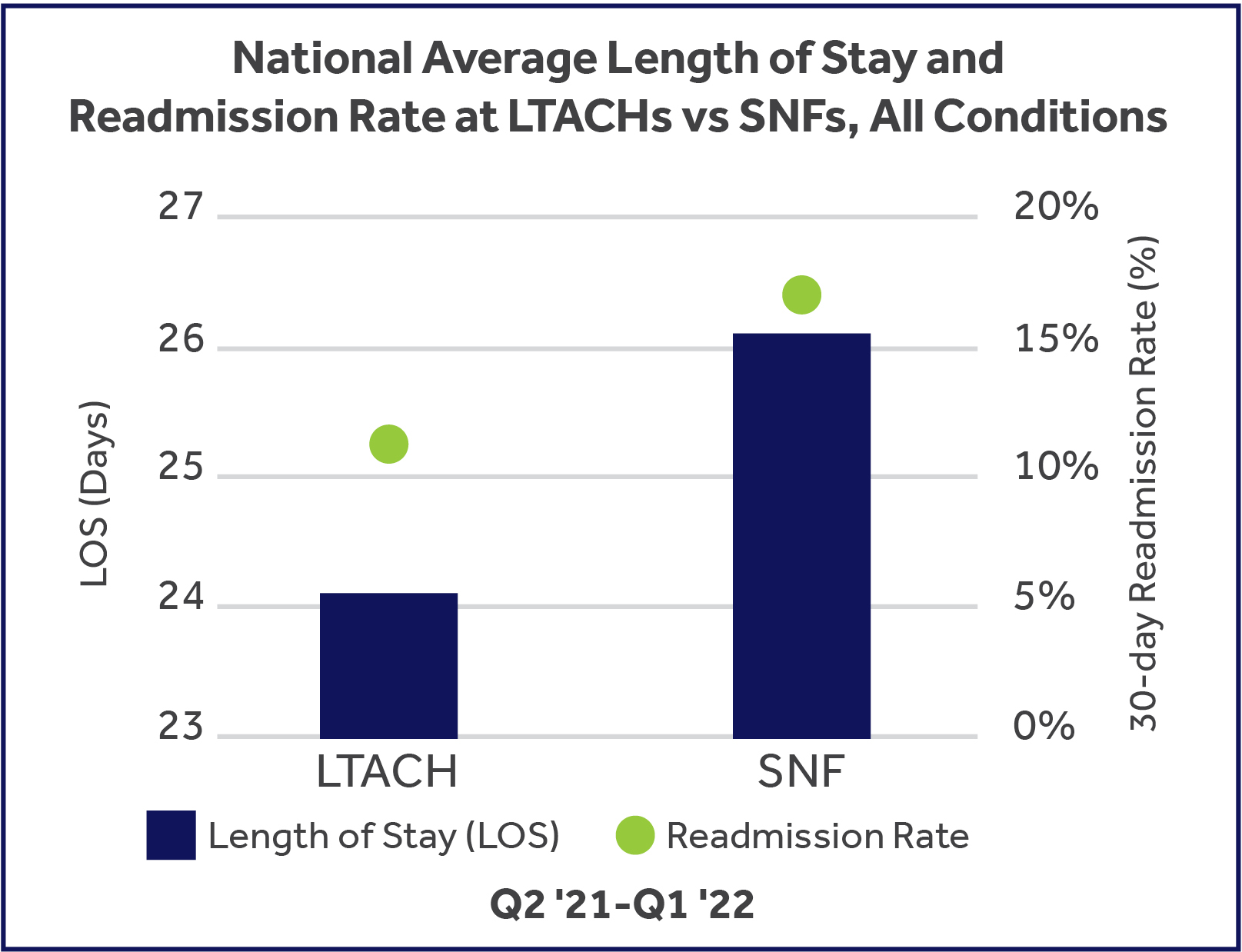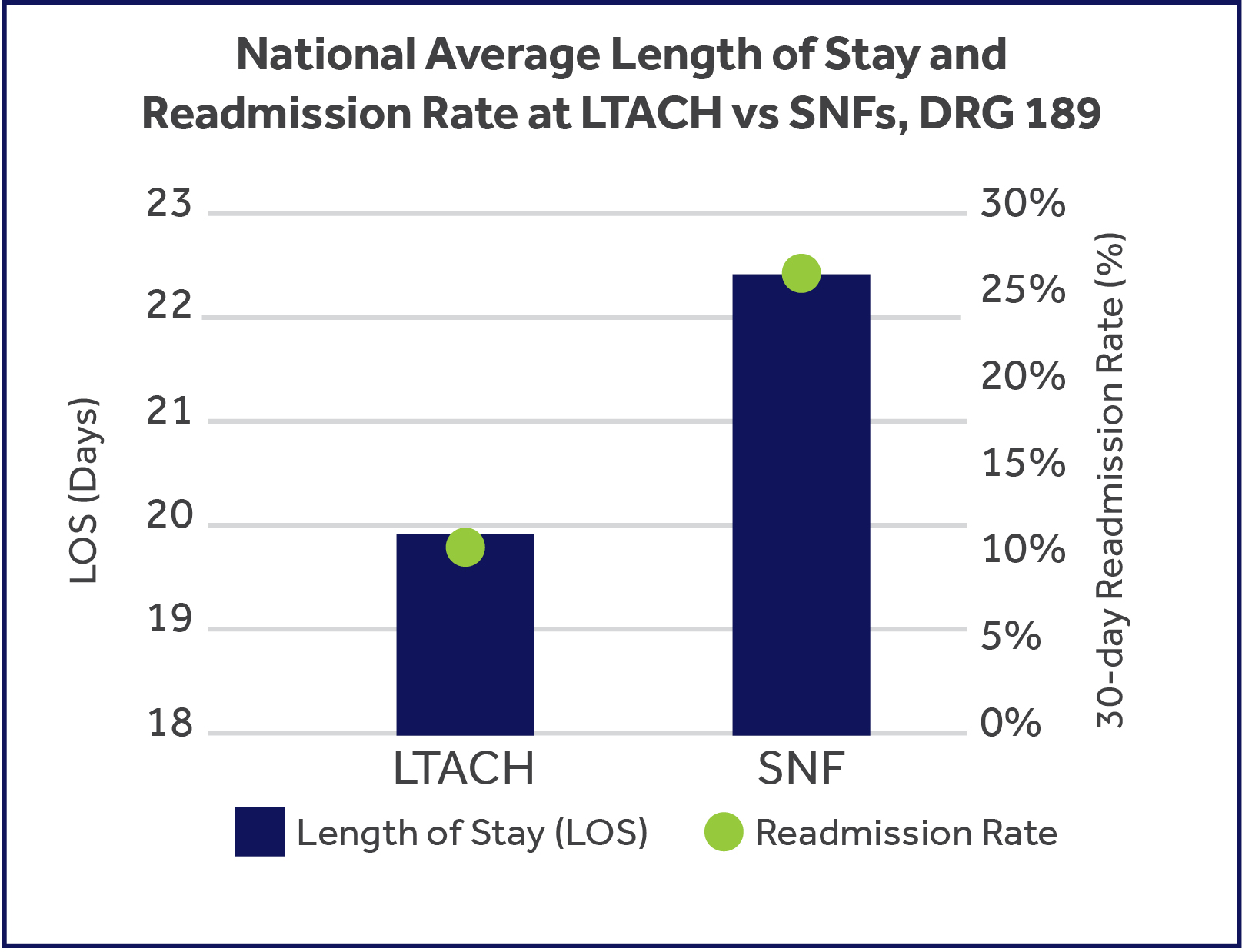Long-term acute care hospitals (LTACHs) and skilled nursing facilities (SNFs) have distinct clinical capabilities, patient populations and hospital outcomes. LTACHs are uniquely equipped to efficiently and effectively meet the needs of medically complex patients, making partnership with LTACHs a key strategy in reducing costs and improving hospital throughput.1
Setting Comparison
Choosing the appropriate level of care for medically complex and critically ill patients leaving the ICU is essential for achieving optimal outcomes for both patients and providers.
The below comparison shows 5 key differences in staff and services available at LTACHs and SNFs:
LTACHs
- On-site physician visits at least once per day, sub-specialists available on location
- Approximately 1-6 patients per nurse, ratios lower in critical care units; High-acuity care provided by BLS- and ACLS-certified nurses with advanced critical care training
- 24/7 respiratory therapy in house in every location
- Onsite services such as telemetry, radiology, pharmacy, lab, and dialysis
- CMS-compliant infection control standards with hospital-level air ventilation systems and negative pressure isolation rooms
SNFs
- On-site physician visits at least once every 30 days for the first 90 days, sub-specialists seen offsite
- Approximately 10-40 patients per nurse
- Limited respiratory therapy in select locations
- Radiology, pharmacy, lab, and dialysis services accessible, but not onsite
- Residential-level air ventilation systems
The differences in available staff and resources between LTACHs and SNFs means that they are designed to treat different types and severities of conditions.
Top Five Conditions by Setting
LTACHs2
- Pulmonary edema and respiratory failure
- Respiratory system diagnosis with ventilator for 96+ hours
- Septicema without ventilator support 96+ hours with major complication or comorbidity
- Respiratory system diagnosis with ventilator support ≤96 hours
- Respiratory infections and inflammations with major complication or comorbidity
SNFs3
- COVID-19
- Urinary tract infection, site
- not specified
- Metabolic encephalopathy
- Sepsis, unspecified organism
- Encounter for other orthopedic aftercare
Aside from the differences in principle admitting condition, many of the top conditions treated at LTACHs include a major complication or comorbidity. The Hierarchical Condition Category (HCC) score, which assigns complexity levels to patients, was almost 2X higher at LTACHs than SNFs in 2021.4 Additionally, while only a small percentage of patients discharged to a SNF present an “extreme” Severity of Illness, these patients make up over half the population transitioning to an LTACH.5
With physician-led acute care, LTACHs are able to treat patients with complex and serious conditions, most of which include a pulmonary diagnosis. SNFs, on the other hand, care for a wide range of conditions that can be managed by nursing staff.
Comparing Outcomes
When critically ill patients, especially those with complex pulmonary conditions, receive the specialized acute care available at LTACHs, they are well positioned to fully recover faster.
Even though patients at LTACHs tend to have more complex conditions, they experience both shorter lengths of stay (LOS) and fewer readmissions than those at SNFs.4 This is particularly clear when looking at pulmonary diagnoses such as DRG 189, one of the most commonly treated at LTACHs.


How Partnership with Kindred Hospitals Can Help Your Hospital
Each year, the Centers for Medicare & Medicaid Services, penalizes hospitals for excessive 30-day readmission rate. In 2018, over 2,500 hospitals were penalized, amounting to more than $564 million.6 Strategic partnership with an LTACH is one initiatve that can help your hospital reduce readmissions and improve outcomes for medically complex patients, while also increasing throughput.
As an industry leader with a history of successful partnerships, Kindred Hospital offers hospital-in-hospital, contract management and joint-venture opportunities. Expand access to needed acute care services by integrating a Kindred Hospital into your health system’s care continuum today.
Discover how your hospital can benefit from an LTACH partnership by visiting KindredLTACHPartner.com.
Sources
1.https://www.tandfonline.com/doi/full/10.3111/13696998.2010.551163
2.https://www.medpac.gov/wp-content/uploads/2022/03/Mar22_MedPAC_ReportToCongress_v3_SEC.pdf
3.https://www.definitivehc.com/resources/healthcare-insights/top-snf-diagnoses
4.https://dag.advisory.com/MarketExplorer/PAC/National/1X7SCS72
5.https://www.aha.org/system/files/media/file/2019/04/fact-sheet-ltch-0319.pdf
6.https://www.advisory.com/daily-briefing/2017/08/07/hospital-penalties

